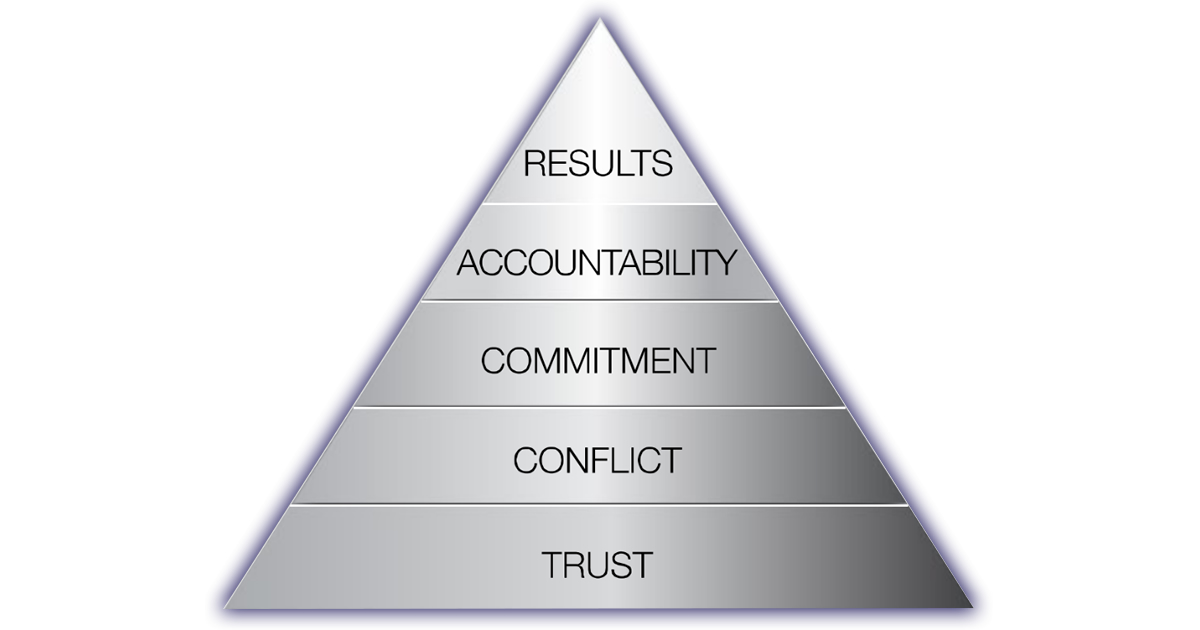Building a cohesive team is more than assembling talented professionals; it’s about nurturing an environment where collaboration thrives and collective success becomes achievable. Team development doesn’t happen overnight—achieving a high-performing, high-functioning team requires intentional focus on specific behaviors that drive collaboration and trust. Here, we explore the five behaviors of a cohesive team (based on Patrick Lencino’s “5 Dysfunctions of a Team”, renamed for “Five Behaviors of a Cohesive Team”), how these concepts can help teams achieve collective results, some examples and strategies for each of the five factors.
Cohesive Team
A cohesive team operates as a unified force where members share a clear vision, common goals, and mutual trust. Effective teams can debate ideas openly, resolve conflicts constructively, and support each other through challenges. Patrick Lencioni’s model, The Five Dysfunctions of a Team, introduced the foundational idea of vulnerability-based trust as a key element in team success. Without a strong base of trust, even the most skilled professionals can fail to operate cohesively.
The cohesive team model emphasizes the importance of building genuinely transparent relationships where team members can express their opinions openly. This transparency allows intact teams to spot potential challenges early, creating opportunities for growth while steering clear of destructive conflict.
Behaviors of a Cohesive Team
The five behaviors model outlines critical habits every team must develop to operate as a high-functioning unit. These behaviors include establishing trust, engaging in productive conflict, committing to decisions, holding each other accountable, and focusing on results. Each behavior builds on the others, forming the backbone of authentic team development solutions.
- Trust
Vulnerability-based trust is the foundation of a cohesive team. When team members feel comfortable being genuinely transparent—admitting mistakes, asking for help, or offering opinions—they improve collaboration and mutual respect. Example: A leader who candidly shares their own challenges sets the tone for others to do the same, fostering openness and collaboration.
Example: A leader who candidly shares their own challenges sets the tone for others to do the same, fostering openness and collaboration.
Actionable Strategies
- Introduce team-building activities focused on sharing personal stories or experiences.
- Promote transparency by encouraging leaders to admit mistakes and discuss areas of growth.
- Utilize tools like personality assessments to deepen understanding between team members.
By building trust, teams can dismantle silos and form genuine connections that enhance organizational success.
- Constructive Conflict
Teams cannot avoid conflict altogether. However, fostering productive conflict allows members to engage in healthy debates, consider diverse perspectives, and explore solutions critically. Unlike destructive conflict, which fractures relationships, constructive debate strengthens bonds and leads to innovative ideas.
 Example: High-performing teams encourage differing opinions and welcome difficult conversations to explore innovative solutions.Actionable Strategies
Example: High-performing teams encourage differing opinions and welcome difficult conversations to explore innovative solutions.Actionable Strategies
- Set ground rules for respectful debates during team discussions.
- Encourage leaders to model healthy conflict by inviting dissenting perspectives.
- Create a culture where disagreements are seen as an opportunity to improve outcomes rather than a threat.
- Commitment
Alignment around common goals ensures a team remains focused on shared objectives. Clarity and agreement during decision-making encourage every member to move forward confidently, even when individual preferences differ. Example: A sports team may differ on strategies but align on execution once a play is chosen, ensuring everyone works toward the same objective.Actionable Strategies
Example: A sports team may differ on strategies but align on execution once a play is chosen, ensuring everyone works toward the same objective.Actionable Strategies
- End key meetings by clearly stating the decisions made and confirming team members’ commitment.
- Develop a shared vision by tying decisions to overarching organizational goals.
- Ensure all voices are heard during meetings to strengthen engagement.
Clear and demonstrated commitment empowers staff to move forward with confidence and focus on achieving team-wide success.
- Accountability
High-performing teams stay accountable to one another. Accountability includes checking progress reports, addressing unmet commitments, and maintaining alignment with agreed deliverables. Example: Cohesive teams that practice peer accountability encourage members to provide constructive feedback and address concerns directly.Actionable Strategies
Example: Cohesive teams that practice peer accountability encourage members to provide constructive feedback and address concerns directly.Actionable Strategies
- Build a framework for regular peer feedback and performance reviews.
- Set measurable objectives and assign clear ownership for tasks.
- Celebrate shared achievements while addressing gaps as learning opportunities.
A culture of accountability ensures teams prioritize collective success and improve team dynamics consistently over time.
- Achieving Results
The ultimate goal of any team building process is to achieve collective results. While individual achievements matter, the cohesive team model prioritizes team-wide success. When teams focus on the big picture, their competitive advantage grows exponentially. Example: A leadership team with predefined, measurable KPIs can actively track progress and align individual contributions to group objectives.Actionable Strategies
Example: A leadership team with predefined, measurable KPIs can actively track progress and align individual contributions to group objectives.Actionable Strategies
- Establish clear, collective goals at the outset of every project.
- Regularly review progress toward key performance indicators (KPIs).
- Reinforce the importance of team success over individual achievements in regular communications.
Shifting attention to shared results motivates teams to align their efforts, driving measurable organizational success.
Behaviors Assessment
Understanding where a team stands is essential to progress. Adding structured behaviors assessments—such as the Five Behaviors Assessment—can help intact teams gauge their cohesion levels, uncover blind spots, and identify opportunities for personal development. These assessments provide leaders with actionable feedback to tailor efforts and align strategies with the team’s goals.
All assessments should include discussions about progress reports, emphasizing the importance of accountability in reaching milestones. Regular evaluations also ensure that short-term corrections lead to long-term success—a vital part of better teamwork.
When teams focus on the five key behaviors—trust, conflict, commitment, accountability, and results—they create a foundation for sustainable growth. The ultimate goal is not only to achieve shared results but also to solidify a competitive advantage that enables the team to excel in a constantly evolving environment.
By implementing these behaviors and continuously refining them through feedback and assessments, teams can transform into dynamic units that deliver results beyond expectations. Better teamwork isn’t just a goal; it’s a process that leads to enduring success.
Bridgeline Executive Coaching and Leadership Development offers specialized workshops (The 5 Behaviors of Successful Teams) designed to help teams address these dysfunctions head-on. These workshops include behavioral assessments for the team, and we guide you through hands-on, experiential exercises to build trust and refine alignment, which play a crucial role in achieving extraordinary results. The ultimate measure of your success will be your organization’s transformation.
Contact us to explore if this workshop is right for you.



